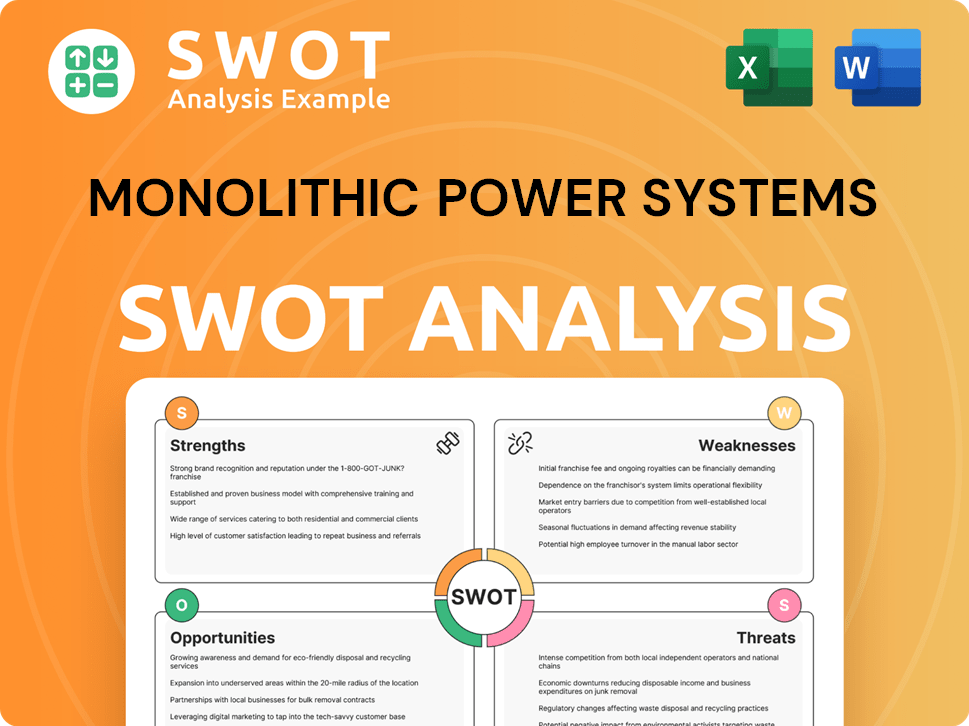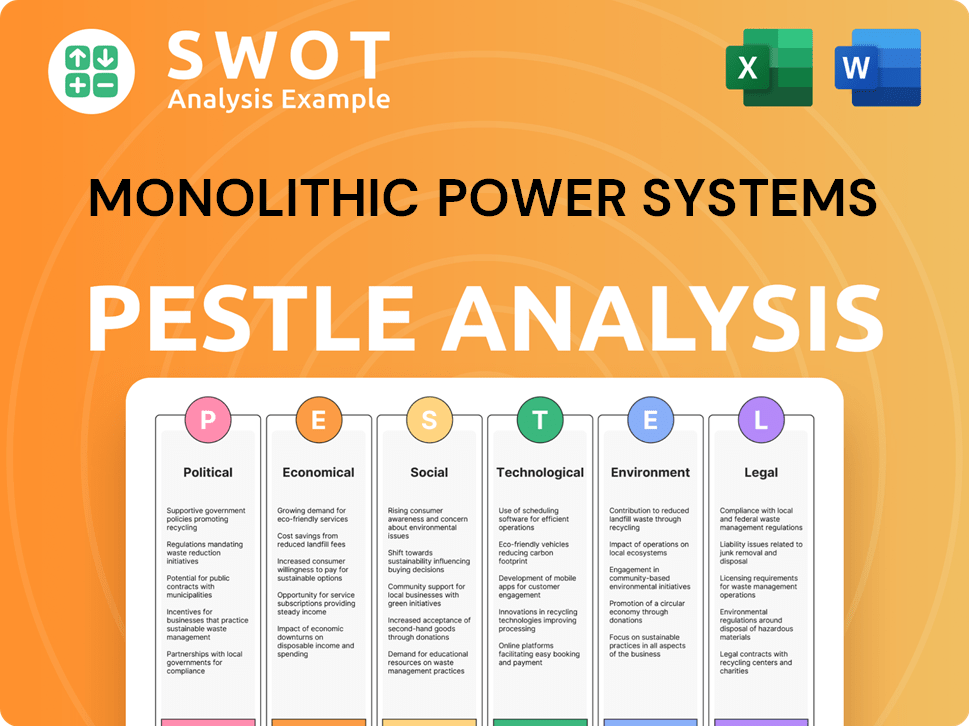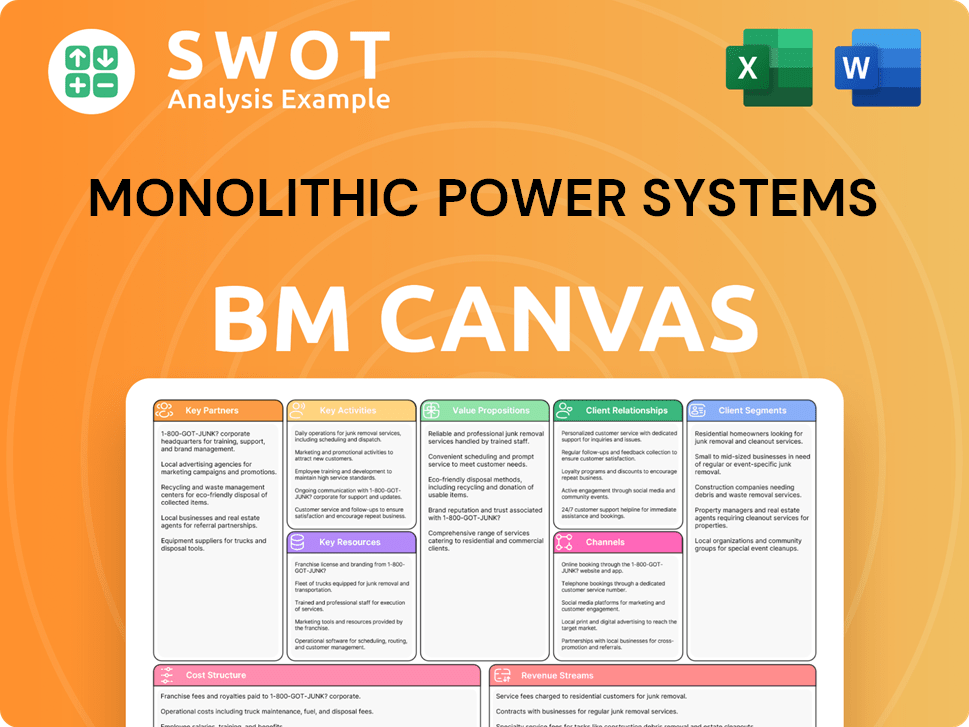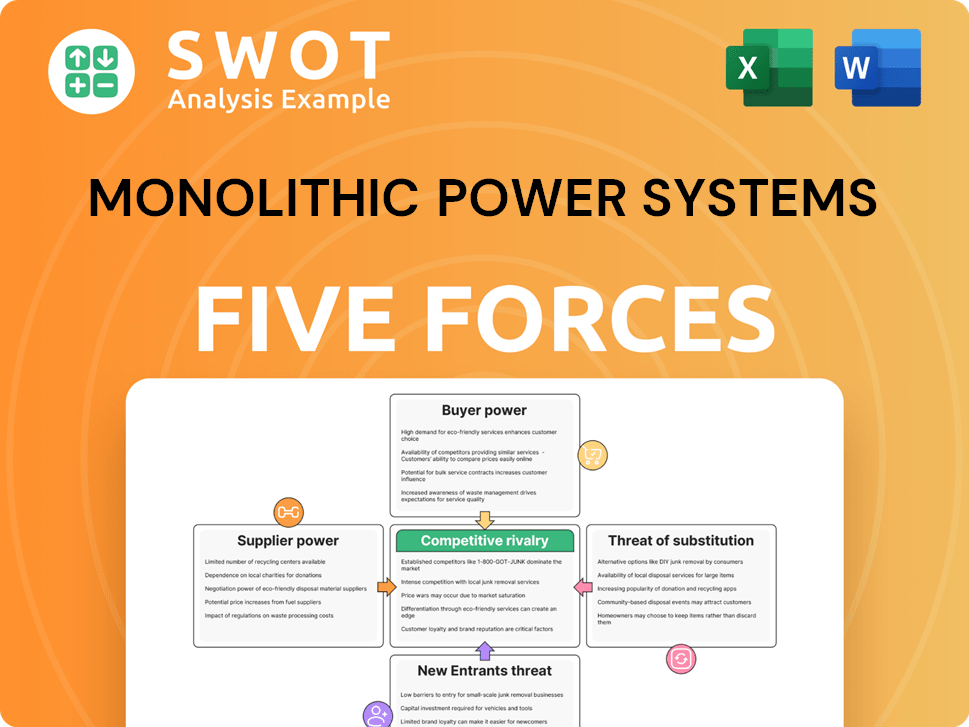Monolithic Power Systems Bundle
How Does Monolithic Power Systems Stack Up Against the Competition?
The semiconductor industry is a battlefield of innovation, and Monolithic Power Systems (MPS) is a key player in the power management arena. Founded in 1997, MPS has steadily grown, making a name for itself in high-performance analog and mixed-signal integrated circuits. But how does MPS Company navigate this competitive landscape, and what sets it apart?

To truly understand MPS's position, a thorough Monolithic Power Systems SWOT Analysis is essential. This deep dive into the Competitive Landscape will explore MPS's strategic positioning, key rivals, and the competitive advantages that drive its success. We'll analyze the MPS market share, examine the challenges, and explore the future of Monolithic Power Systems within the dynamic Semiconductor Industry, providing a comprehensive market analysis.
Where Does Monolithic Power Systems’ Stand in the Current Market?
Monolithic Power Systems (MPS) specializes in high-performance analog and mixed-signal integrated circuits, primarily focusing on power management solutions. The company's core operations revolve around designing, developing, and marketing these integrated circuits, which are essential for managing power in various electronic devices and systems. MPS's value proposition lies in providing efficient, reliable, and compact power management solutions that enhance the performance and extend the battery life of electronic devices.
MPS's products are designed to address the growing need for efficient power management in a wide range of applications. These applications include computing, automotive, industrial, communications, and consumer electronics. The company's focus on innovation and its ability to deliver highly integrated solutions have enabled it to establish a strong market presence and maintain a competitive edge in the semiconductor industry. The company's commitment to research and development is evident in its substantial R&D spending, which further supports its long-term growth strategy.
In the fiscal year 2023, MPS reported total revenue of approximately $1.82 billion, showcasing its significant financial scale within the semiconductor industry. This financial performance underscores the company's strong market position and its ability to generate substantial revenue. The company's revenue is distributed across several key geographic regions, with a significant portion coming from Asia.
MPS has a strong global presence, with a significant portion of its revenue derived from Asia. China accounted for 44% of its 2023 revenue. The United States and Europe also represent substantial markets for the company.
MPS's products are integral to a diverse range of applications. These include computing (data centers, laptops), automotive (infotainment, ADAS), industrial (smart meters, factory automation), communications (5G infrastructure), and consumer electronics (home appliances, portable devices).
MPS consistently invests in research and development. R&D expenses reached $336.5 million in 2023. This investment supports its strategy of expanding into higher-growth markets like automotive and industrial applications.
While specific market share figures are not always publicly detailed, MPS is recognized as a leader in various power management sub-segments. It is particularly known for its highly integrated solutions that prioritize efficiency and compact design. To learn more about MPS's strategic approach, consider reading the Growth Strategy of Monolithic Power Systems.
MPS has a strong market position due to its financial performance and strategic focus on high-growth markets. The company's revenue and R&D investments demonstrate its commitment to innovation and expansion. Its diverse product applications and global presence solidify its position in the semiconductor industry.
- Strong revenue of approximately $1.82 billion in 2023.
- Significant investment in R&D, with expenses reaching $336.5 million in 2023.
- A strong presence in key markets such as Asia, the United States, and Europe.
- Focus on high-growth markets like automotive and industrial applications.
Monolithic Power Systems SWOT Analysis
- Complete SWOT Breakdown
- Fully Customizable
- Editable in Excel & Word
- Professional Formatting
- Investor-Ready Format

Who Are the Main Competitors Challenging Monolithic Power Systems?
The competitive landscape for Monolithic Power Systems (MPS) is characterized by intense rivalry within the analog and mixed-signal integrated circuit market. This environment demands continuous innovation and strategic positioning to maintain and grow market share. Understanding the strengths and weaknesses of key competitors is crucial for MPS to make informed decisions and capitalize on market opportunities.
MPS faces competition from a mix of established and emerging players in the power management sector. These competitors vary in size, product offerings, and market focus, creating a complex and dynamic competitive environment. The ability to differentiate through technology, cost-effectiveness, and customer relationships is critical for success.
The semiconductor industry is constantly evolving, with companies adapting to changing market demands and technological advancements. MPS's competitive strategy must account for these shifts, including mergers and acquisitions, which can reshape the competitive dynamics. The company must stay agile and responsive to maintain its position.
The primary direct competitors of MPS include major players in the semiconductor industry. These companies offer a broad range of products that compete directly with MPS's power management solutions. They often have substantial resources and established customer bases.
Texas Instruments (TI) is a significant competitor, offering a vast portfolio of analog and embedded processing products, including power management ICs. TI's extensive product range and global presence allow it to compete effectively in various markets. In 2024, TI's revenue was approximately $17.5 billion, with a substantial portion derived from analog products, indicating its strong position in the market.
Analog Devices (ADI) specializes in high-performance analog and mixed-signal integrated circuits. ADI's focus on high-end applications and strong presence in industrial and automotive markets make it a formidable competitor. ADI reported revenues of around $12.3 billion in 2024, reflecting its strong market position and technological capabilities.
Renesas Electronics competes with MPS, particularly in the automotive and industrial sectors. Renesas offers a broad range of power management ICs and embedded solutions. In 2024, Renesas' revenue was approximately $10.5 billion, demonstrating its significant presence in key markets.
Infineon Technologies is a key competitor, especially in automotive and industrial power applications. Infineon's focus on power semiconductors and system solutions makes it a strong player in these sectors. In fiscal year 2024, Infineon's revenue was approximately €16.3 billion, highlighting its strong position in the power management market.
STMicroelectronics (STMicro) has a broad range of power management and embedded processing solutions. STMicro's diverse product portfolio and global presence allow it to compete effectively across various markets. In 2024, STMicroelectronics' revenue was around $14.3 billion, reflecting its significant market share.
In addition to the major players, MPS faces indirect competition from companies offering alternative power solutions or from customers developing in-house power management capabilities. Smaller, specialized firms focusing on niche power management areas also contribute to the competitive landscape. These companies often leverage specific technological advantages to compete.
- Alternative Power Solutions: Companies providing alternative power solutions, such as discrete components or power modules, can indirectly compete with MPS's integrated circuits.
- In-House Development: Some customers, particularly large OEMs, may choose to develop in-house power management capabilities for specific applications, reducing demand for MPS's products.
- Niche Players: Smaller firms specializing in specific areas of power management, such as high-efficiency power conversion or specialized battery management, can pose a competitive threat in their respective niches.
- Mergers and Acquisitions: The competitive landscape is also shaped by mergers and acquisitions. For example, Renesas' acquisition of Dialog Semiconductor expanded its product portfolio and market share.
Monolithic Power Systems PESTLE Analysis
- Covers All 6 PESTLE Categories
- No Research Needed – Save Hours of Work
- Built by Experts, Trusted by Consultants
- Instant Download, Ready to Use
- 100% Editable, Fully Customizable

What Gives Monolithic Power Systems a Competitive Edge Over Its Rivals?
Understanding the competitive advantages of Monolithic Power Systems (MPS) is crucial for a thorough market analysis of the semiconductor industry. MPS Company distinguishes itself through its unique business model and technological innovations. These factors significantly influence its position within the competitive landscape.
Monolithic Power Systems leverages a 'fabless' model, combining it with proprietary process technologies to create highly integrated power management solutions. This approach enables them to offer products that are both efficient and compact, which is a critical advantage in various applications. The company's focus on research and development, coupled with a strong patent portfolio, further solidifies its competitive position.
The company's commitment to innovation and customer relationships contributes to its success. MPS has cultivated strong customer relationships and a reputation for delivering high-quality, reliable solutions. Their agile design methodology and ability to rapidly develop new products tailored to specific customer needs also contribute to their competitive edge.
MPS utilizes proprietary BCD (Bipolar-CMOS-DMOS) process technology, allowing integration of power, analog, and digital circuits on a single chip. This integration leads to optimized performance and often reduces overall system costs. This technological prowess is a key differentiator in the power management market.
The 'fabless' business model allows MPS to focus on design and innovation, outsourcing manufacturing to specialized foundries. This strategy enhances flexibility and reduces capital expenditure. The company's supply chain management also plays a crucial role in maintaining operational efficiency.
MPS emphasizes strong customer relationships and provides high-quality, reliable solutions. Their agile design capabilities enable them to develop products tailored to specific customer needs. This focus fosters customer loyalty and supports long-term partnerships.
Monolithic Power Systems has demonstrated consistent financial performance, reflecting its strong market position. For the year 2024, the company reported a revenue of approximately $1.8 billion, indicating robust growth. This financial success is a testament to its competitive advantages and strategic execution. For more insights into the company's structure, consider reading about the Owners & Shareholders of Monolithic Power Systems.
Monolithic Power Systems maintains a competitive edge through its proprietary technologies, efficient operational model, and strong customer relationships. These advantages are crucial in the power management market.
- Proprietary BCD process technology for integrated solutions.
- 'Fabless' model for focused innovation and flexibility.
- Strong customer relationships and tailored product development.
- Consistent financial performance and market share growth.
Monolithic Power Systems Business Model Canvas
- Complete 9-Block Business Model Canvas
- Effortlessly Communicate Your Business Strategy
- Investor-Ready BMC Format
- 100% Editable and Customizable
- Clear and Structured Layout

What Industry Trends Are Reshaping Monolithic Power Systems’s Competitive Landscape?
The competitive landscape for Monolithic Power Systems (MPS) is dynamic, shaped by industry trends and the strategic moves of its rivals. A thorough understanding of the competitive environment is crucial for investors and stakeholders. This analysis delves into the key aspects influencing MPS, providing insights into its position, potential risks, and future outlook within the power management market.
Analyzing the Growth Strategy of Monolithic Power Systems is essential for understanding its competitive stance. MPS operates within a highly competitive semiconductor industry, where innovation and adaptability are key to survival and growth. The company faces both opportunities and challenges, which will determine its success in the evolving power management sector.
The power management market is significantly influenced by several industry trends. Demand for energy-efficient electronics is growing rapidly, driven by environmental concerns and cost savings. The automotive sector, particularly EVs and ADAS, presents a major growth area for high-performance power solutions.
MPS faces challenges such as supply chain complexities and intense competition from larger semiconductor companies. The cyclical nature of the semiconductor industry can lead to fluctuating demand and pricing pressures. Managing these challenges effectively is crucial for maintaining profitability and market share.
Emerging markets, such as industrial IoT and smart home devices, offer significant growth opportunities. Continued investment in research and development, particularly in GaN and SiC-based power solutions, can drive innovation. Strategic partnerships and acquisitions can also expand market reach and technological capabilities.
MPS's competitive position is likely to evolve towards greater specialization in high-power, high-efficiency solutions. Leveraging proprietary technologies and focusing on specific market segments can help MPS maintain a strong market position. This specialization allows for targeted innovation and customer solutions.
The power management market is highly competitive, with key players vying for market share. Understanding the competitive landscape involves analyzing MPS competitors, their strategies, and their market positioning. This includes evaluating factors such as product offerings, technological innovation, and financial performance.
- Market Share: MPS's market share in specific segments like automotive and industrial applications is growing.
- Competitive Analysis: Key competitors include Texas Instruments, Analog Devices, and Infineon Technologies.
- Product Comparison: MPS's products are often compared based on efficiency, power density, and reliability.
- Financial Performance: MPS's revenue has shown consistent growth, reflecting its strong market position. In 2024, the company reported revenues of approximately $1.8 billion.
Monolithic Power Systems Porter's Five Forces Analysis
- Covers All 5 Competitive Forces in Detail
- Structured for Consultants, Students, and Founders
- 100% Editable in Microsoft Word & Excel
- Instant Digital Download – Use Immediately
- Compatible with Mac & PC – Fully Unlocked

Related Blogs
- What are Mission Vision & Core Values of Monolithic Power Systems Company?
- What is Growth Strategy and Future Prospects of Monolithic Power Systems Company?
- How Does Monolithic Power Systems Company Work?
- What is Sales and Marketing Strategy of Monolithic Power Systems Company?
- What is Brief History of Monolithic Power Systems Company?
- Who Owns Monolithic Power Systems Company?
- What is Customer Demographics and Target Market of Monolithic Power Systems Company?
Disclaimer
All information, articles, and product details provided on this website are for general informational and educational purposes only. We do not claim any ownership over, nor do we intend to infringe upon, any trademarks, copyrights, logos, brand names, or other intellectual property mentioned or depicted on this site. Such intellectual property remains the property of its respective owners, and any references here are made solely for identification or informational purposes, without implying any affiliation, endorsement, or partnership.
We make no representations or warranties, express or implied, regarding the accuracy, completeness, or suitability of any content or products presented. Nothing on this website should be construed as legal, tax, investment, financial, medical, or other professional advice. In addition, no part of this site—including articles or product references—constitutes a solicitation, recommendation, endorsement, advertisement, or offer to buy or sell any securities, franchises, or other financial instruments, particularly in jurisdictions where such activity would be unlawful.
All content is of a general nature and may not address the specific circumstances of any individual or entity. It is not a substitute for professional advice or services. Any actions you take based on the information provided here are strictly at your own risk. You accept full responsibility for any decisions or outcomes arising from your use of this website and agree to release us from any liability in connection with your use of, or reliance upon, the content or products found herein.